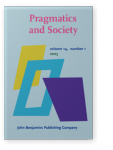Vol. 14:1 (2023) ► pp.143–169
Would you like a bag for that?
Environmental awareness and changing practices for closing buying and selling encounters in retail shopping
This article presents a study of participants’ practices for closing buying-selling encounters in retail shops. The study shows how the handing over of a shopping bag with the items purchased serves as a resource for organizing the closing of the encounter. Further, taking its point of departure in the growing societal awareness of the environmental impact of plastic waste, the study investigates how customers’ increasing avoidance of single-use shopping bags contributes to changing their practices for closing a buying-selling encounter, as the bags no longer provide a resource around which the closing can be organized.
The article uses ethnomethodological conversation analytic (EMCA) methods to describe how customers and sales assistants create and maintain the local order of the shop and how they, through their multimodal and embodied contributions, bring societal discourses into the buying-selling encounter.
The data consists of 22 shopping sequences, recorded in Danish shops in 2018.
Article outline
- Introduction
- Closing an interaction: Conversation analytic studies
- Methods
- Data
- Accomplishing the closing of a buying-selling encounter: Shopping bags as a resource for organizing closing
- The organization of encounters in which the customer accepts a bag
- The organization of encounters in which the customer does not want a bag
- No bag 1: Delaying the completion of the transfer
- No bag 2: Different understandings of when the closing of the encounter is complete
- No bag 3: Potential orientation to the moral implications of refusing a bag
- Discussion and conclusion
- Note
-
References
